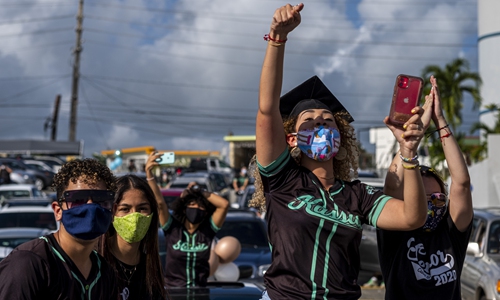Spanish statue keeled in Puerto Rico before King’s visit
Imperial legacy symbol toppled

Graduating students from the Ramon Power Y Giralt High School wear face masks during a symbolic graduation from their cars to maintain social distance at a parking lot in Las Piedras, Puerto Rico on Wednesday. The event was organized by the municipal government to congratulate the local graduates whose traditional ceremonies were canceled due to the coronavirus pandemic, with the condition of staying inside their vehicles. Photo: AFP
Puerto Rican authorities hastily reinstalled a statue of Spanish explorer Juan Ponce de Leon that was toppled earlier Monday in the capital San Juan, just hours before a visit to the Caribbean island by Spain's King Felipe VI.
"Some individuals approached the statue," located in a square in the historic center of San Juan, and "caused damage," according to a police report quoted by local media.
The capital's mayor, Miguel Romero, criticized the incident as an "act of vandalism" in remarks to news outlet El Nuevo Dia, but sought to downplay the significance of the incident and the extent of the damage.
Felipe VI arrived hours later. He was visiting Puerto Rico, a US territory, in order to mark the 500th anniversary of San Juan's founding.
The city's origins date back to 1521, but the official celebrations were delayed due to the COVID-19 pandemic.
Authorities indicated they were looking at security camera footage to help identify those who damaged the statue.
Local media reported that a group known as the Boriken Libertarian Forces has claimed responsibility.
"Faced with the visit of the King of Spain, Felipe VI, to Puerto Rico and the escalation of 'gringo' invaders taking over our lands, we want to send a clear message: Neither kings nor 'gringo' invaders," the group wrote in a statement.
Before the statue was reinstalled, Rafael Capo, a 35-year-old history teacher, decided to climb the empty pedestal in protest.
For him, there is a direct link between the veneration of the Spanish colonial past, and Puerto Rico's current political relationship with the US.
"Five hundred years later, history continues to repeat itself. They keep importing people from outside to get rid of the locals," he said, referring to current government policies that offer tax benefits to foreigners, mostly wealthy Americans.
Police removed Capo and other protesters so municipal authorities could reinstall the statue, which they said was not severely damaged.
The statue was forged in 1882 in New York, with bronze obtained from British cannons captured after a failed attack on the Spanish in Puerto Rico.
Because the US obtained the island from Spain at war, people born in Puerto Rico are US citizens who can move to the US mainland if they choose.
But because people born in Puerto Rico do not have normal voting representation in the US House of Representatives and Senate, political analysts widely consider their political status to be colonial.
AFP
